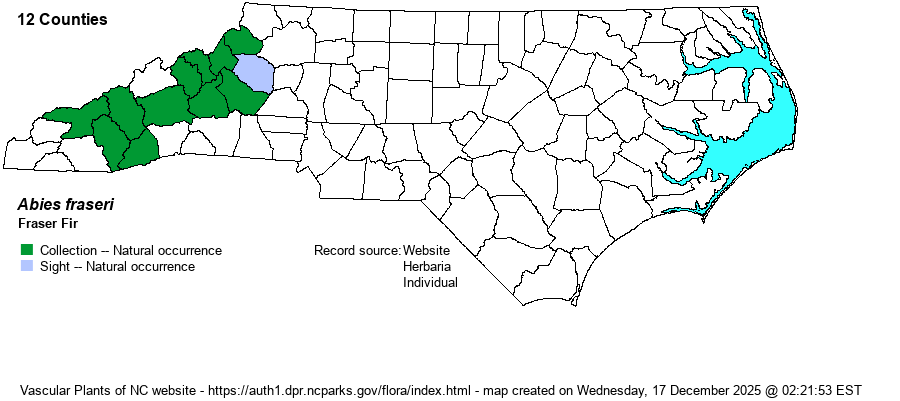| Author | (Pursh) Poiret | |
| Distribution | Only at the highest elevations, mainly over 5000 feet, and the dominant tree above 6000 feet. Ranges south to the southern end of the Blue Ridge Parkway in Jackson and Transylvania counties.
This is a Southern Appalachian endemic, ranging from southwestern VA south to southwestern NC and adjacent TN (only found in these three states as native populations). It is closely related to Balsam Fir (A. balsamea), which ranges south in the central Appalachians to western VA.
| |
| Abundance | Globally a very rare (G2) species, but it is the most numerous tree at the state’s highest elevations. Thus, it usually forms solid stands above 6000 feet, and is mixed with Red Spruce (Picea rubens) down to about 5000 feet. On many peaks it has suffered significant death due to the balsam woolly adelgid and to acid precipitation. Populations are still doing well in some areas, such as at Roan Mountain and Grandfather Mountain, less so in the Great Smoky Mountains and along the southern portions of the Blue Ridge Parkway. Despite its G2 rank, the NC NHP considers it as a Watch List species, at W5 (strongly declining); it ought to be considered for State Protected status. | |
| Habitat | The species is found on the tops and slopes of the highest peaks, often on rocky soil, in a cold microclimate. It forms forests by itself or with spruce, and at times with hardwoods. |
| Phenology | Flowering cones formed in May and June, and cones ripen from September to November. | |
| Identification | This is the familiar Christmas tree that so many people in the East purchase each December. It is an evergreen, small to medium tree, at best, growing to about 40-50 feet tall. It has a “neat”, symmetrical appearance, of straight branches angling upward from the trunk, somewhat parallel to other branches. It can be separated from the similar Red Spruce by the flat (two-dimensional) needles that are rounded at the tips; when you put your hand around a twig, the needles are soft-feeling and they do not feel sharp on the skin. (Spruce needles are square in cross-section and are stiffer; grasping a twig will cause some discomfort.) The two hemlock species – Eastern (Tsuga canadensis) and Carolina (T. caroliniana) – have needles that are not densely or spirally arranged on the twigs; fir needles are very dense on the twigs and typically curve upwards. In addition, when visible, cones of the fir grow erect from the top of a stem; spruce and hemlock cones dangle below a stem. | |
| Taxonomic Comments | None
| |
| Other Common Name(s) | At times written as Fraser’s Fir, technically the more appropriate name, as the species is named after a person and not a town, location, etc. However, it has been generally accepted to be written as Fraser Fir. She Balsam is a “silly” colloquial name; Southern Balsam. | |
| State Rank | S2 | |
| Global Rank | G2 | |
| State Status | W5 | |
| US Status | | |
| USACE-agcp | | |
| USACE-emp | FACU link |

